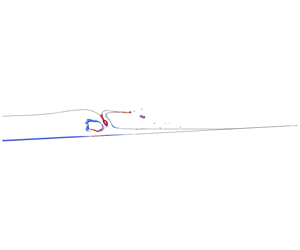Crossref Citations
This article has been cited by the following publications. This list is generated based on data provided by
Crossref.
Sakakeeny, Jordan
and
Ling, Yue
2020.
Natural oscillations of a sessile drop on flat surfaces with mobile contact lines.
Physical Review Fluids,
Vol. 5,
Issue. 12,
Wu, Jiarong
and
Deike, Luc
2021.
Wind wave growth in the viscous regime.
Physical Review Fluids,
Vol. 6,
Issue. 9,
Turkoz, Emre
Stone, Howard A.
Arnold, Craig B.
and
Deike, Luc
2021.
Simulation of impulsively induced viscoelastic jets using the Oldroyd-B model.
Journal of Fluid Mechanics,
Vol. 911,
Issue. ,
Berny, A.
Popinet, S.
Séon, T.
and
Deike, L.
2021.
Statistics of Jet Drop Production.
Geophysical Research Letters,
Vol. 48,
Issue. 10,
Farsoiya, Palas Kumar
Popinet, Stéphane
and
Deike, Luc
2021.
Bubble-mediated transfer of dilute gas in turbulence.
Journal of Fluid Mechanics,
Vol. 920,
Issue. ,
Perrard, Stéphane
Rivière, Aliénor
Mostert, Wouter
and
Deike, Luc
2021.
Bubble deformation by a turbulent flow.
Journal of Fluid Mechanics,
Vol. 920,
Issue. ,
Sakakeeny, Jordan
and
Ling, Yue
2021.
Numerical study of natural oscillations of supported drops with free and pinned contact lines.
Physics of Fluids,
Vol. 33,
Issue. 6,
Rivière, Aliénor
Mostert, Wouter
Perrard, Stéphane
and
Deike, Luc
2021.
Sub-Hinze scale bubble production in turbulent bubble break-up.
Journal of Fluid Mechanics,
Vol. 917,
Issue. ,
Zdyrski, Thomas
and
Feddersen, Falk
2022.
Wind-induced changes to shoaling surface gravity wave shape.
Physical Review Fluids,
Vol. 7,
Issue. 7,
Estivalezes, J.-L.
Aniszewski, W.
Auguste, F.
Ling, Y.
Osmar, L.
Caltagirone, J.-P.
Chirco, L.
Pedrono, A.
Popinet, S.
Berlemont, A.
Magnaudet, J.
Ménard, T.
Vincent, S.
and
Zaleski, S.
2022.
A phase inversion benchmark for multiscale multiphase flows.
Journal of Computational Physics,
Vol. 450,
Issue. ,
p.
110810.
Kanehira, Taiga
McAllister, Mark L.
Draycott, Samuel
Nakashima, Takuji
Ingram, David M.
van den Bremer, Ton S.
and
Mutsuda, Hidemi
2022.
The effects of smoothing length on the onset of wave breaking in smoothed particle hydrodynamics (SPH) simulations of highly directionally spread waves.
Computational Particle Mechanics,
Vol. 9,
Issue. 5,
p.
1031.
Lowe, R.J.
Altomare, C.
Buckley, M.L.
da Silva, R.F.
Hansen, J.E.
Rijnsdorp, D.P.
Domínguez, J.M.
and
Crespo, A.J.C.
2022.
Smoothed Particle Hydrodynamics simulations of reef surf zone processes driven by plunging irregular waves.
Ocean Modelling,
Vol. 171,
Issue. ,
p.
101945.
Patankar, Sagar
Basak, Saswata
and
Dasgupta, Ratul
2022.
Dynamic stabilisation of Rayleigh–Plateau modes on a liquid cylinder.
Journal of Fluid Mechanics,
Vol. 946,
Issue. ,
Iwata, Yoritaka
and
Nishikawa, Takashi
2022.
Inertial energy dissipation in nuclear dynamics.
Physical Review C,
Vol. 105,
Issue. 4,
Xie, Zhihua
and
Lin, Pengzhi
2022.
Eulerian and Lagrangian transport by shallow-water breaking waves.
Physics of Fluids,
Vol. 34,
Issue. 3,
Mostert, W.
Popinet, S.
and
Deike, L.
2022.
High-resolution direct simulation of deep water breaking waves: transition to turbulence, bubbles and droplets production.
Journal of Fluid Mechanics,
Vol. 942,
Issue. ,
Wu, Jiarong
Popinet, Stéphane
and
Deike, Luc
2022.
Revisiting wind wave growth with fully coupled direct numerical simulations.
Journal of Fluid Mechanics,
Vol. 951,
Issue. ,
Mohanlal, Sunil
Harris, Jeffrey C.
Yates, Marissa L.
and
Grilli, Stephan T.
2023.
Unified depth-limited wave breaking detection and dissipation in fully nonlinear potential flow models.
Coastal Engineering,
Vol. 183,
Issue. ,
p.
104316.
Feddersen, Falk
Fincham, Adam M.
Brodie, Katherine L.
Young, Adam P.
Spydell, M.S.
Grimes, Derek J.
Pieszka, Michal
and
Hanson, Kentaro
2023.
Cross-shore wind-induced changes to field-scale overturning wave shape.
Journal of Fluid Mechanics,
Vol. 958,
Issue. ,
Guo, Chunyu
Ji, Minglei
Han, Yang
Liu, Tian
Wu, Yanyuan
and
Kuai, Yunfei
2023.
Numerical simulation of the horizontal rotating cylinder and the air entrainment near the free surface.
Physics of Fluids,
Vol. 35,
Issue. 9,





